
List of princes of Liechtenstein
Encyclopedia

Sovereignty
Sovereignty is the quality of having supreme, independent authority over a geographic area, such as a territory. It can be found in a power to rule and make law that rests on a political fact for which no purely legal explanation can be provided...
monarch
Monarch
A monarch is the person who heads a monarchy. This is a form of government in which a state or polity is ruled or controlled by an individual who typically inherits the throne by birth and occasionally rules for life or until abdication...
and head of state
Head of State
A head of state is the individual that serves as the chief public representative of a monarchy, republic, federation, commonwealth or other kind of state. His or her role generally includes legitimizing the state and exercising the political powers, functions, and duties granted to the head of...
of Liechtenstein
Liechtenstein
The Principality of Liechtenstein is a doubly landlocked alpine country in Central Europe, bordered by Switzerland to the west and south and by Austria to the east. Its area is just over , and it has an estimated population of 35,000. Its capital is Vaduz. The biggest town is Schaan...
. The Princely Family of Liechtenstein
Princely Family of Liechtenstein
The Liechtenstein dynasty, from which the principality takes its name, is the family which reigns by constitutional, hereditary right over the nation of Liechtenstein...
, after which the sovereign principality was named in 1719, hails from Castle Liechtenstein in Lower Austria
Lower Austria
Lower Austria is the northeasternmost state of the nine states in Austria. The capital of Lower Austria since 1986 is Sankt Pölten, the most recently designated capital town in Austria. The capital of Lower Austria had formerly been Vienna, even though Vienna is not officially part of Lower Austria...
, which the family possessed from at least 1140 to the thirteenth century, and from 1807 onward.
History
Through the centuries, the dynasty acquired vast swathes of land, predominantly in MoraviaMoravia
Moravia is a historical region in Central Europe in the east of the Czech Republic, and one of the former Czech lands, together with Bohemia and Silesia. It takes its name from the Morava River which rises in the northwest of the region...
, Lower Austria
Lower Austria
Lower Austria is the northeasternmost state of the nine states in Austria. The capital of Lower Austria since 1986 is Sankt Pölten, the most recently designated capital town in Austria. The capital of Lower Austria had formerly been Vienna, even though Vienna is not officially part of Lower Austria...
, Silesia
Silesia
Silesia is a historical region of Central Europe located mostly in Poland, with smaller parts also in the Czech Republic, and Germany.Silesia is rich in mineral and natural resources, and includes several important industrial areas. Silesia's largest city and historical capital is Wrocław...
, and Styria, though in all cases, these territories were held in fief under other more senior feudal lords, particularly under various lines of the Habsburg
Habsburg
The House of Habsburg , also found as Hapsburg, and also known as House of Austria is one of the most important royal houses of Europe and is best known for being an origin of all of the formally elected Holy Roman Emperors between 1438 and 1740, as well as rulers of the Austrian Empire and...
family, to whom several Liechtenstein princes served as close advisors. Thus, and without any territory held directly under the Imperial throne, the Liechtenstein dynasty was unable to meet a primary requirement to qualify for a seat in the Imperial diet, the Reichstag
Reichstag (Holy Roman Empire)
The Imperial Diet was the Diet, or general assembly, of the Imperial Estates of the Holy Roman Empire.During the period of the Empire, which lasted formally until 1806, the Diet was not a parliament in today's sense; instead, it was an assembly of the various estates of the realm...
.
The family yearned greatly for the added power which a seat in the Imperial government would garner, and therefore, searched for lands to acquire which would be unmittelbar (non-intermediate), held without any feudal personage other than the Holy Roman Emperor
Holy Roman Emperor
The Holy Roman Emperor is a term used by historians to denote a medieval ruler who, as German King, had also received the title of "Emperor of the Romans" from the Pope...
himself having rights on the land. After some time, the family was able to arrange the purchase of the minuscule Herrschaft ("Lordship") of Schellenberg
Schellenberg
Schellenberg is a municipality in the lowland area of Liechtenstein, on the banks of the Rhine. , it has a population of 952 and covers an area of .-Early history:...
and countship of Vaduz
Vaduz
Vaduz is the capital of the principality of Liechtenstein and the seat of the national parliament. The town, located along the Rhine, has about 5,100 inhabitants , most of whom are Roman Catholic. Its cathedral is the seat of a Roman Catholic archbishop....
(in 1699 and 1712 respectively) from the Hohenems
Waldburg-Zeil
Waldburg-Zeil was a County located in southeastern Baden-Württemberg, Germany, located around Zeil. Waldburg-Zeil was a partition of Waldburg-Wolfegg-Zeil...
. Tiny Schellenberg and Vaduz possessed exactly the political status required, no feudal lord other than their comital
Count
A count or countess is an aristocratic nobleman in European countries. The word count came into English from the French comte, itself from Latin comes—in its accusative comitem—meaning "companion", and later "companion of the emperor, delegate of the emperor". The adjective form of the word is...
sovereign and the suzerain
Suzerainty
Suzerainty occurs where a region or people is a tributary to a more powerful entity which controls its foreign affairs while allowing the tributary vassal state some limited domestic autonomy. The dominant entity in the suzerainty relationship, or the more powerful entity itself, is called a...
Emperor.
Thereby, on January 23, 1719, after purchase had been duly made, Charles VI, Holy Roman Emperor
Charles VI, Holy Roman Emperor
Charles VI was the penultimate Habsburg sovereign of the Habsburg Empire. He succeeded his elder brother, Joseph I, as Holy Roman Emperor, King of Bohemia , Hungary and Croatia , Archduke of Austria, etc., in 1711...
, decreed Vaduz and Schellenberg were united, and raised to the dignity of Fürstentum (principality
Principality
A principality is a monarchical feudatory or sovereign state, ruled or reigned over by a monarch with the title of prince or princess, or by a monarch with another title within the generic use of the term prince....
) with the name "Liechtenstein" in honour of "[his] true servant, Anton Florian of Liechtenstein
Anton Florian of Liechtenstein
Anton Florian, Prince of Liechtenstein was the Prince of Liechtenstein between 1718 and 1721.He was born in Wilfersdorf, in what is now Lower Austria...
". It is on this date that Liechtenstein
Liechtenstein
The Principality of Liechtenstein is a doubly landlocked alpine country in Central Europe, bordered by Switzerland to the west and south and by Austria to the east. Its area is just over , and it has an estimated population of 35,000. Its capital is Vaduz. The biggest town is Schaan...
became a sovereign member state of the Holy Roman Empire
Holy Roman Empire
The Holy Roman Empire was a realm that existed from 962 to 1806 in Central Europe.It was ruled by the Holy Roman Emperor. Its character changed during the Middle Ages and the Early Modern period, when the power of the emperor gradually weakened in favour of the princes...
. Ironically, but as testament to the pure political expediency of the purchases, the Princes of Liechtenstein did not permanently live in their new principality for over 200 years, moving only in 1938 into the Alpine territory.
Powers
The Prince of Liechtenstein has sweepingly broad powers; a referendumReferendum
A referendum is a direct vote in which an entire electorate is asked to either accept or reject a particular proposal. This may result in the adoption of a new constitution, a constitutional amendment, a law, the recall of an elected official or simply a specific government policy. It is a form of...
to adopt Hans-Adam's revision of the constitution
Constitution of Liechtenstein
There has been a written constitution in the Principality of Liechtenstein since 5 October 1921. It was granted by Johann II, Prince of Liechtenstein, and established the rule of parliamentary democracy mixed with that of constitutional monarchy. It has twelve chapters covering the...
to expand his powers passed in 2003. The changes also included a republican option, whereby the Prince was henceforth formally barred from vetoing any bill to establish a republic. The Prince can however veto any other law. In addition, the right to secede of the parishes which make up the Principality was recognized. Prince Hans-Adam had threatened that he and his family would move to Austria
Austria
Austria , officially the Republic of Austria , is a landlocked country of roughly 8.4 million people in Central Europe. It is bordered by the Czech Republic and Germany to the north, Slovakia and Hungary to the east, Slovenia and Italy to the south, and Switzerland and Liechtenstein to the...
if the referendum had failed. Despite opposition from Mario Frick, a former Prime Minister, the Prince's referendum motion was carried by the electorate. Opponents accused Hans-Adam of engaging in emotional blackmail to achieve his goal and constitutional experts from the Council of Europe
Council of Europe
The Council of Europe is an international organisation promoting co-operation between all countries of Europe in the areas of legal standards, human rights, democratic development, the rule of law and cultural co-operation...
branded the event as a retrograde move.
On 15 August 2004 Prince Hans-Adam II formally turned the power of making day-to-day governmental decisions over to his son Prince Alois, as a way of transitioning to a new generation. Formally, Hans-Adam remains Head of State
Head of State
A head of state is the individual that serves as the chief public representative of a monarchy, republic, federation, commonwealth or other kind of state. His or her role generally includes legitimizing the state and exercising the political powers, functions, and duties granted to the head of...
.
The U.S. Senate's subcommittee on tax haven banks has charged that the documents and information provided by Heinrich Kieber show that the LGT bank which is owned by the princely family, and on whose board they serve "is a willing partner, and an aider and abettor to clients trying to evade taxes, dodge creditors or defy court orders." For the same reasons, a 1999 German secret service report more bluntly described Liechtenstein as "a criminal state in the heart of Europe".
Titles
According to their House Laws, the Reigning Prince shall bear the title:- Reigning Prince of Liechtenstein, Duke of TroppauDuchy of TroppauThe Principality or Duchy of Troppau or Opava was based for centuries around the Upper Silesian city of Troppau . In the final four centuries of its existence, the Duchy belonged to the Austrian Habsburg dynasty, and it was dissolved with the Habsburg Empire in 1918...
and Jägerndorf, Count of RietbergRietbergRietberg is a town in the district of Gütersloh in the state of North Rhine-Westphalia, Germany. It is located approx. 10 km south of Gütersloh and 25 km north-west of Paderborn in the region Ostwestfalen-Lippe. The town is located at the river Ems. There are 28,878 people living in...
, Sovereign of the House of Liechtenstein
List of Princes of Liechtenstein
| # | Picture | Name | Prince From | Prince Until |
|---|---|---|---|---|
| 1 | 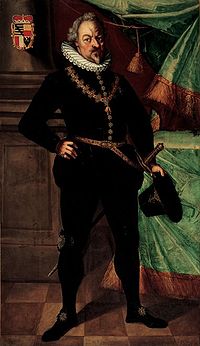 |
Karl I | 1608 | 12 February 1627 |
| 2 | 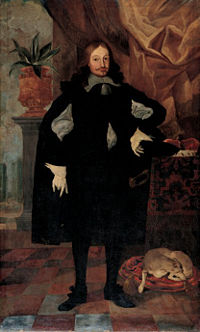 |
Karl Eusebius | 12 February 1627 | 5 April 1684 |
| 3 | 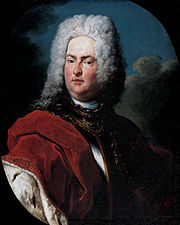 |
Hans-Adam I Hans-Adam I, Prince of Liechtenstein Hans-Adam I, Prince of Liechtenstein was the Prince of Liechtenstein. He was the son of Karl Eusebius, Prince of Liechtenstein and Johanna Beatrix, Countess of Dietrichstein to Nikolsburg .In 1699 he acquired the domain of Schellenberg, and in 1712 the county of Vaduz... |
1699 | 6 June 1712 |
| 4 |  |
Joseph Wenzel I | 16 June 1712 | 1718 |
| 5 | Anton Florian | 1718 | 11 October 1721 | |
| 6 | 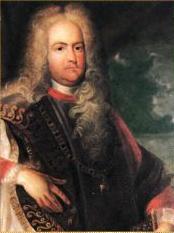 |
Joseph Johann Adam | 11 October 1721 | 16 December 1732 |
| 4 |  |
Joseph Wenzel I | 1732 | 1745 |
| 7 | Johann Nepomuk Karl | 16 December 1732 | 22 December 1748 |
|
| 4 |  |
Joseph Wenzel I | 22 December 1748 | 10 February 1772 |
| 8 | 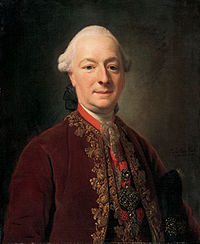 |
Franz Joseph I | 10 February 1772 | 18 August 1781 |
| 9 | Aloys I | 18 August 1781 | 24 March 1805 |
|
| 10 | Johann I Joseph | 24 March 1805 | 20 April 1836 |
|
| 11 | Aloys II | 20 April 1836 | 12 November 1858 |
|
| 12 | Johann II | 12 November 1858 | 11 February 1929 |
|
| 13 | 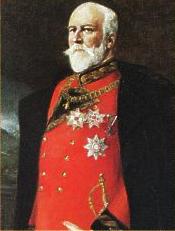 |
Franz I Franz I, Prince of Liechtenstein Franz I, Prince of Liechtenstein, born Franz de Paula Maria Karl August was the Prince of Liechtenstein between 1929 and 1938. He was the son of Aloys II of Liechtenstein and his wife Countess Franziska Kinsky... |
11 February 1929 | 25 July 1938 |
| 14 | Franz Joseph II Franz Joseph II, Prince of Liechtenstein Franz Joseph II, Prince of Liechtenstein, , was the Sovereign Prince of Liechtenstein from 1938 until his death... |
25 July 1938 | 13 November 1989 |
|
| 15 | Hans-Adam II Hans-Adam II, Prince of Liechtenstein Hans-Adam II , is the reigning Prince of Liechtenstein. He is the son of Franz Joseph II, Prince of Liechtenstein and his wife Countess Georgina von Wilczek . He also bears the titles Duke of Troppau and Jägerndorf, Count of Rietberg... |
13 November 1989 |
Present |
See also
- List of princesses of LiechtensteinPrincess of Liechtenstein- House of Liechtenstein :...
- Line of succession to the Liechtensteiner throne
- Princely Family of LiechtensteinPrincely Family of LiechtensteinThe Liechtenstein dynasty, from which the principality takes its name, is the family which reigns by constitutional, hereditary right over the nation of Liechtenstein...
- Ducal hat of Liechtenstein
- 2008 Liechtenstein tax affair2008 Liechtenstein tax affairThe 2008 Liechtenstein tax affair is a series of tax investigations in numerous countries whose governments suspect that some of their citizens may have evaded tax obligations by using banks and trusts in Liechtenstein; the affair broke open with the biggest complex of investigations ever initiated...

